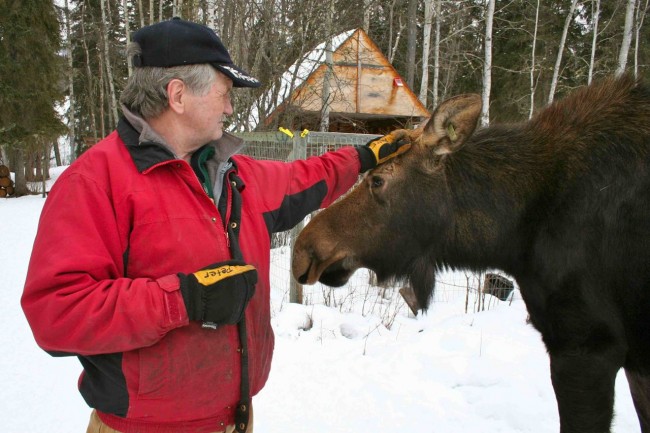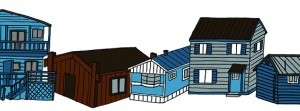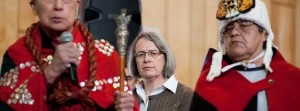
A wild life: The Langen’s unexpected career
It’s a long, winding and increasingly narrow road that snakes and climbs its way above Smithers towards the land that Angelika and Peter Langen call home. Following in the footsteps of Angelika’s father, the Langens arrived from Germany in the early 1980s, originally with the intention of starting a trail-riding business. With a few rescue horses and scarce finances, a small business grew.
Angelika is strong and youthful-looking. Only the baby monitor on the kitchen table tells that today, 30 years after their arrival, there is a grandchild sleeping upstairs, a fourth generation of the family to join the Canadian branch. Angelika grew up in Cologne, the daughter of a man in the business of owl breeding and research.
“I raised my first owlet aged 7,” she says, her accent still strong. “I was always in the company of some animal, feathers or whatever.”
Angelika trained as a zookeeper, meeting her husband Peter at the Cologne Zoo and setting in motion a personal and professional partnership that both admit has not been entirely predictable.
The view from the Langens’ house takes in their horse fields and trails. A cabin down the slope houses school kids each summer for horse-riding and educational visits.
Next-door is a feed room that, on inspection, suggests than they share their home not just with humans and horses. A young woman stands at a wide workbench, knife in hand, chopping endless vegetables and meat into numerous, very large buckets. She grins, “I’m sorry about the smell! When you have this many animals, it takes quite a lot of food.”
Peter, a wiry and weathered modern-day Dr Doolittle in red Gortex and bright orange gloves, explains: “It’s a great spot here, well sheltered from the weather and other houses. There was lots of room here to build enclosures for the moose, bears, and the big cats.”
It started with a moose
It was in 1986 that Angelika and Peter read in the local newspaper about a moose that had been killed by a train; her two motherless calves were then shot by a conservation officer. In Germany there were facilities to take in injured or orphaned wildlife, rehabilitate and release them…so why not in BC?
The couple, now running their trail-riding business, contacted previous employers who could vouch for their qualifications and experience in rearing animals in captivity. A proposal was submitted to the provincial government, requesting that they be able to take in animals as need arose.
“Then we hit a brick wall,” says Angelika, “This is where some good German stubbornness kicked in!”
Angelika and Peter couldn’t understand why the Ministry’s default position was that killing vulnerable animals was preferable to exploring other options. Unless something like rehabilitation had been proved unworkable, why not let them try it? After four years of wrangling, their permits were in place.
In 1989 they received their first moose calf. But despite four days of their best efforts—youthful vigour, enthusiasm, but a complete lack of any real knowledge—the moose died.
“It was a real knock to the ego. Peter and I just looked at each other and said, ‘Really—what are we really doing?’”
But with each new arrival their experience grew, as did a realization that theirs was quite a different task than they’d originally envisaged.
“We learned that all the animals coming to the shelter were, in some way, on death’s doorstep. So to have expected instant success with such sick, wild animals was naïve—it took quite a few years to really learn this lesson.”
Early visitors passing through the shelter included moose, deer, foxes and squirrels. There were, however, no recipe books detailing the perfect feed formulae for such animals, so the Langens became adept at concocting mixes of various animal milks in search of just the right ones for their guests. Two decades later things are much more straightforward, if expensive, as they can now buy pails of species-specific feed for around $200.
“Importing large buckets of white powder through customs is always interesting!” Angelika notes.
A year-round job
In 1991 they received their first bear. “It wasn’t a conscious decision but, because we had the facilities and there was clearly a need, over the next few years we sort of ended up specializing in moose, deer and bears.” Peter nods, adding “That’s what we mainly have now—we’ve gotten pretty good with them.”
Which is an understatement, given that the couple now sits at the heart of a worldwide network of animal rehabilitation experts. They speak at international conferences on the subject, host Masters research students, are mentors for the first brown bear rehabilitation program in Greece and the first moose and deer rehabilitation program in Idaho. Youthful naivety has been replaced with a vast wealth of experience, though no less vigour.
The Langens formally registered the Northern Lights Wildlife Society in 2002. Different seasons bring different challenges: abandoned infant animals arrive mainly in spring, largely a result of traffic accidents or residential shootings. Raising them while maintaining the facilities, writing grants, fundraising (they receive no public funding) and public outreach, alongside their trail-riding business, would be a feat for the most energetic of families.
It is the Langens’ work with bears, however, that draws the most attention. Yet despite rehabilitating and returning 237 black bears into the wild in the last 22 years, their work still flies largely under the BC public radar. In response to this, Angelika is emphatic about the need to engage more BC citizens in an open and frank discussion about wildlife management.
“The public are well aware how frequently bears are shot in towns, attracted to open trash, or that bear cubs are commonly euthanized because of the argument that rehabilitation creates nuisance bears,” she says.
What much fewer people know is that no bear raised and released by the Langens, to date, has sought further human contact.
Don’t call us bear-huggers
“From the beginning,” Angelika says, “it was very hard to get help or advice on how to get people talking about our work.” But they are up for the challenge.
“Unlike a lot of people that are good with animals, I’m also good with people. I like to get out and talk, and I want the public to know that we’re not doing this just to save cute animals, to make ourselves feel good. We’re not bear-huggers,” she explains bluntly.
“The government’s favourite phrase is ‘let nature take its course.’ I have to ask, ‘What has nature to do with cars and trains killing countless mother animals, and with people shooting them?’ We are not out to save every life possible, but are offering a possibility to offset the impact we humans have on wildlife, and at the same time provide an incredible learning opportunity.”
It’s an impassioned plea, which echoes a question that surely many BC residents have pondered. What responsibility do we really have to the environment in which we live, and on which we depend? Hunting and fishing are heavily regulated in an attempt to maintain the province’s natural resources and the livelihoods that depend on them. It begs the question: how many vehicle-wildlife collisions, or rubbish bins left out unlocked, should each person be personally licensed for?
“We really want the public to say what they want,” says Angelika. “If they value our service, they can say so. If they do, then we can work with the government towards a clear message on wildlife rehabilitation and release.”
Until then, on a hill overlooking Smithers, the Langens will continue their unique efforts to offset the impact of BC’s human population on our wilder neighbours.



